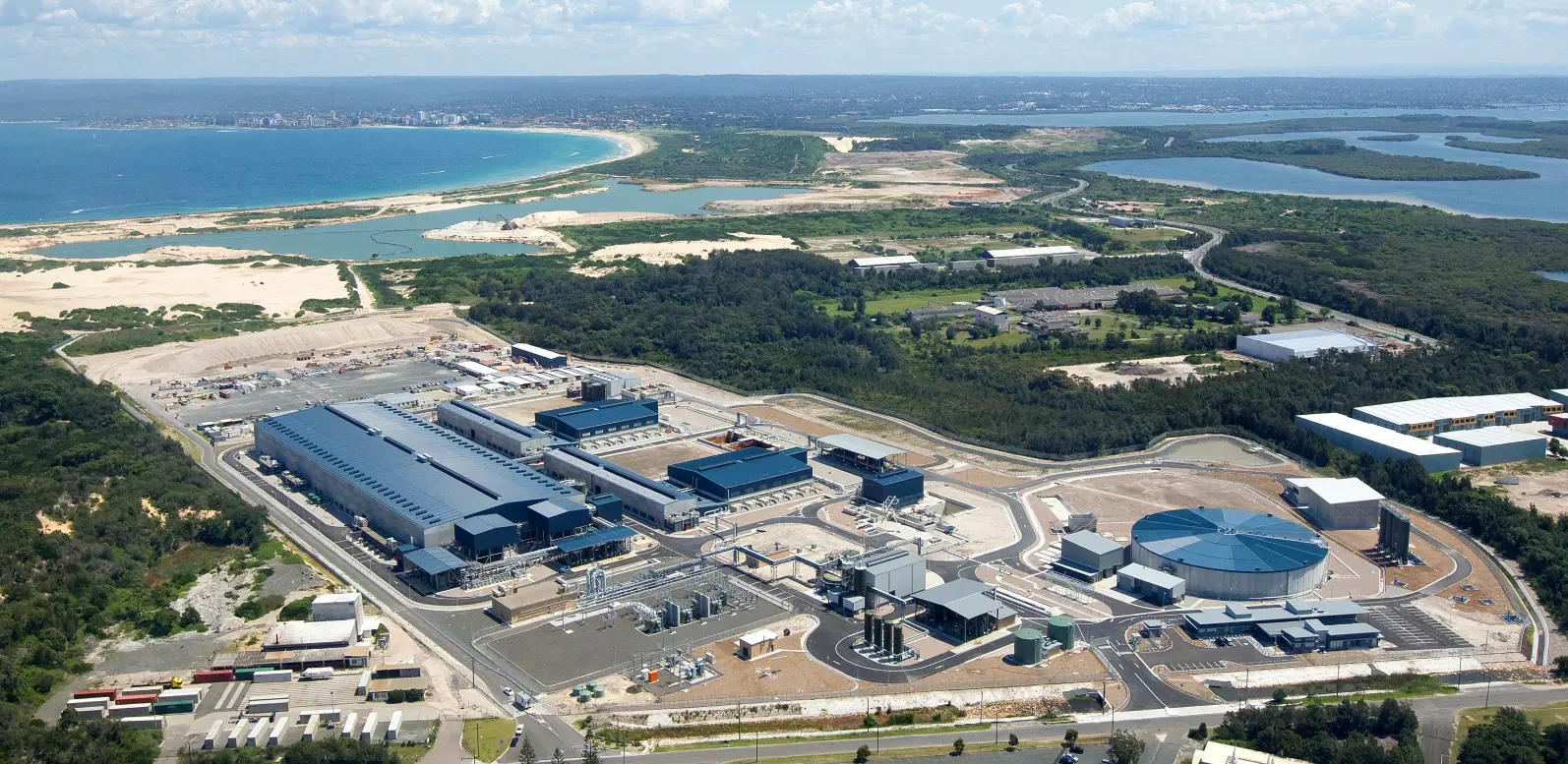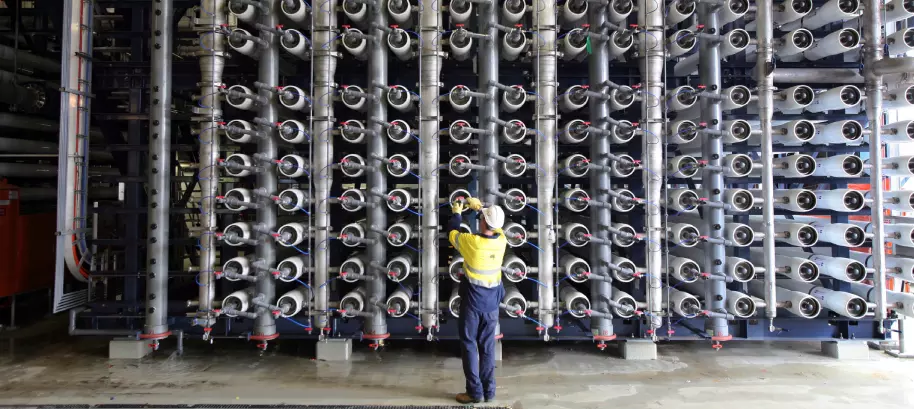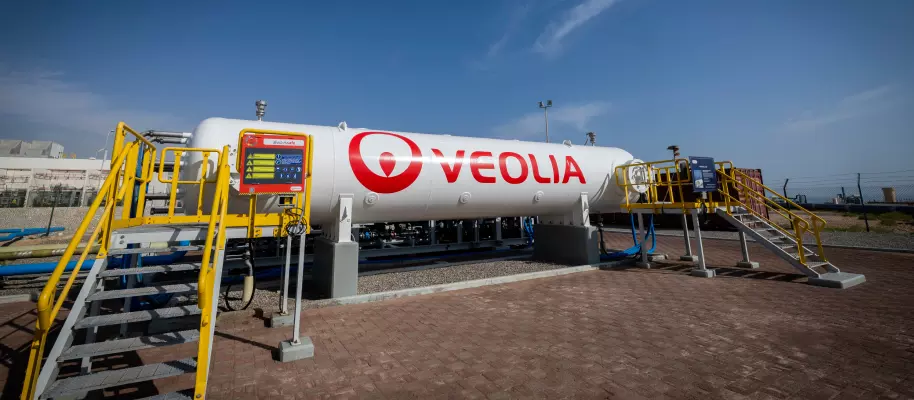Reading time 8 min. #water #city #community #industrial

Arnaud Valleteau de Moulliac
CEO, Engineering and Procurement Projects for water technologies activities, Veolia
I regularly meet with local elected officials and decision-makers who are confronted with a concerning reality: water stress now affects more than 2 billion people worldwide. Whether it is recurrent droughts in Morocco and Spain, or challenges in supplying drinking water to coastal cities, water scarcity is becoming a major issue in our regions. To address this challenge, there is a range of effective solutions that complement each other depending on the territorial issues at stake, such as raising awareness of water scarcity and reducing water consumption, combating water losses in networks (leaks), reusing wastewater and as a final strategic element, desalinating seawater near the coast. Desalination has long been perceived as a costly and energy-intensive solution, but the good news is that technological innovations have revolutionised this approach, transforming it into a viable and sustainable alternative.
In this article, I explain how desalination is turning into a sustainable opportunity, with costs reduced by a factor of five and a significantly reduced environmental impact.

Key points to remember
Water stress affects 80% of the world's population living near the sea. Thanks to recent technological advances, desalination can largely meet this challenge.
Modern technologies have reduced energy consumption fivefold compared to the first generations of installations.
New-generation reverse osmosis now makes it possible to produce drinking water at competitive costs.
The environmental impact is now under control thanks to innovations in brine management and energy efficiency.
Read more below to discover how these technological advances can transform your approach to water security, whether you are responsible for a coastal city or a region experiencing water stress.
Fresh water: a vital challenge for coastal cities facing water stress
What exactly is water stress? Simply put, it is a situation where the demand for water exceeds the resources available in a specific region, but this simple definition hides a complex reality that currently affects many areas.
For several years now, we have been seeing growing tension around water resources on the ground. The figures speak for themselves: 20% of European land and 30% of the continent's population are already affected by water stress every year, and the situation is only getting worse as a result of climate change. Droughts are becoming more frequent, groundwater levels are falling, and conflicts over water use are intensifying, particularly in coastal areas where demographic and tourist pressure is high.
This situation can be explained by several converging factors:
- Population growth in coastal areas
- Climate change, which intensifies droughts
- Over-exploitation of water resources
- Increasing urbanisation, which concentrates demand
For local elected officials and decision-makers, the question is no longer whether water shortages will occur, but when and with what consequences for public health, the local economy and social cohesion. Traditional solutions such as river abstraction, dam storage and inter-basin transfers are showing their limitations, both in terms of availability and environmental acceptability. Agriculture, industry and domestic use are in direct competition with each other, requiring painful decisions.
Take southern Spain, for example. Despite considerable efforts to improve the performance of distribution networks and recycle wastewater, demand far exceeds the natural renewal capacity of the resource. As a result, usage restrictions are imposed every summer, affecting both the daily lives of residents and the vitality of the economy. Australia faces the same challenge: recurring mega-droughts have prompted authorities to thoroughly review their water management strategy.
Even faced with this reality, it is tempting to consider seawater desalination only as a last resort, reserved for only the most extreme situations. However, recent technological advances are changing the game: desalination can now be proactively integrate desalination into the water mix, complementing other levers (reducing losses, reusing wastewater, intelligent demand management).
Technological developments in desalination: from constraint to opportunity
I still remember the first desalination plants I saw fifteen years ago. My impression was mixed: sure, they produced drinking water, but at what energy and financial cost! Today, the situation has completely changed.
Far from the clichés of the past, new-generation desalination is now establishing itself as a credible and competitive response to water security challenges. Thanks to innovation, this technology has reached a decisive milestone in terms of performance, cost and sustainability. Two technologies now dominate the market:
1. Reverse osmosis: the energy efficiency revolution
Reverse osmosis now accounts for 70% of new seawater desalination plants worldwide. The concept is simple: under high pressure, salt water passes through a semi-permeable membrane that retains salts and impurities. The progress made over the last ten years has been spectacular: energy consumption has dropped from 4.5kWh/m³ to less than 3 kWh/m³, driven by membrane optimisation, energy recovery and process digitalisation.
Recent progress includes:
More efficient and durable membranes
Energy recovery systems using pressure exchangers
Optimisation of pre-treatment processes to extend equipment life
The use of digital technology and AI to implement predictive maintenance.

Focus on Barrel™ : innovation for flexibility
Among the solutions we are developing to meet the needs of local authorities and industrial companies, Barrel™ deserves notable attention. This modular technology is revolutionising the approach to reverse osmosis desalination. This compact, scalable plug-and-play module can treat between 400 and 50,000 m³/day with a 25% smaller footprint and 0.05 kWh/m³ lower energy consumption compared to conventional systems.
The Barrel stands out for:
Its modularity: easy adaptation to changing needs
Its compactness: 25% smaller footprint compared to traditional solutions
Its simplified maintenance: easy access to equipment and digital control
- Its energy efficiency: continuous performance optimisation
In short, Barrel™ delivers exactly what local authorities and industries need: a scalable, easy-to-control, and highly efficient solution.
2. Desalination by distillation
Distillation, an ancient process of separating water and salt through evaporation, has benefited from major innovations. Although it consumes more energy, it remains relevant in certain industrial contexts, particularly for smaller facilities, for treating highly contaminated water, or in areas where thermal energy is available at low cost such as operations with industrial waste heat recovery and cogeneration.
Environmental impact: significant progress
One of the main historical obstacles to desalination was its environmental impact. Concerns focused on:
- High energy consumption
- Brine management (highly saline wastewater)
- Impact on marine biodiversity
Today, through innovation, these challenges have been largely overcome:
Reducing our carbon footprint
The energy efficiency of new facilities, coupled with the integration of renewable energies, has enabled us to drastically reduce our carbon footprint. Some facilities now operate entirely on solar energy.
Optimised brine management to protect marine biodiversity
To limit the impact of brine discharges on biodiversity, environmental impact studies are conducted to determine the appropriate measures and discharge points, which are sometimes located several kilometres from the shore. New generations of plants now incorporate controlled dilution and dispersion systems and will soon be equipped with systems for recovering by-products (salts and minerals), based on marine current modelling and environmental monitoring. The aim is to ensure compliance with local standards and the preservation of coastal ecosystems.
Costs and profitability: the economic equation transformed
The question of cost remains central to your investment decisions, but technological developments have significantly improved the economic equation of desalination.
The integration of smart sensors, remote monitoring platforms (Hubgrade) and AI algorithms now makes it possible to optimise the operation of desalination plants in real time. This makes it possible to anticipate maintenance needs, adjust production based on demand, reduce energy and reagent consumption, and improve water quality traceability. This ‘smart plant’ approach is a major lever for operational performance and cost control.
Investment and operating costs
Investment costs have dropped by 50% over the past ten years. This has been driven by standardisation of equipment, improved efficiency and increased competition between suppliers.
Reduced energy consumption has a direct impact on operating costs. A modern facility produces desalinated water for 0.5 to 1 euro per cubic metre, compared to 2 to 3 euros fifteen years ago.
Return on investment
For a coastal community facing water stress, the return on investment for a desalination facility is now between 8 and 12 years, depending on size and configuration.
Seawater desalination: two concrete examples
To illustrate the impact of next-generation desalination in concrete terms, I would like to share two key cases that demonstrate the technical, economic and environmental viability of these solutions.
Palma de Mallorca: securing supplies for a touristic island
On the island of Majorca, the Bahia de Palma desalination plant, which has been in operation since 1999, produces 64,800 m³ of drinking water every day using nine reverse osmosis lines. This strategic facility has made it possible to guarantee water supplies for the local population and millions of tourists, while reducing pressure on groundwater reserves. The digitalisation of operations has optimised energy consumption and reduced operating costs by 15% in five years.
Oman: performance and energy efficiency with Barrel™
In Sur, in the Sultanate of Oman, the integration of Barrel™ has enabled production of 5,000 m³/day with a 3% reduction in the overall cost of the plant and energy savings of 1.5%. The footprint has been reduced by 25%, facilitating integration into a constrained environment. Real-time data collection enables maintenance operations to be anticipated and membrane life to be optimised.
Another unique feature of the site is the installation of a 17-megawatt peak (MWp) solar power plant, with a total of 32,000 photovoltaic panels supplying power to the desalination plant.
"Desalination has become crucial in the Middle East. Our challenge is to ensure it is more efficient and environmentally friendlier than ever."

How to successfully implement a desalination project?
My 10-step action plan:
- Analysis of the local context: assessment of water stress, current and future needs, as well as existing alternatives.
- Consultation with stakeholders: involvement of elected officials, users, associations and economic actors to ensure social acceptability.
- Technical and environmental feasibility study: selection of the most suitable technology (reverse osmosis, distillation, modularity) and analysis of impacts on biodiversity.
- Cost and financing modelling: estimation of investments, operating costs and potential savings (reduction of losses and valorisation of by-products).
- Funding search and dossier preparation: mobilisation of national, European, international and private funding mechanisms, development of a robust business plan.
- Detailed design and choice of equipment: integration of innovations (Barrel™, digitalisation, energy recovery), optimisation of footprint.
- Obtaining regulatory approvals: compliance with local, European and international standards, waste management and environmental monitoring.
- Construction and commissioning: site management, team training, performance testing.
- Real-time supervision and optimisation: deployment of digital platforms, predictive maintenance, and adjustment of operating parameters.
- Communication and information for users: transparency on water quality, promotion of environmental and economic benefits as well as change management support.
Moving to sustainable water security
Modern desalination fits perfectly into a sustainable development approach and offers:
Security of supply independent of climatic hazards
Consistent water quality that meets the most stringent standards
Flexibility to adapt to changing needs
Controlled environmental impact thanks to technological innovations
For regions facing water stress and challenges, this technology represents an opportunity to turn a constraint into a competitive advantage. It makes it possible to secure economic development while preserving natural resources.
Desalination 2.0 is no longer reserved for the Gulf countries. It is becoming a relevant solution for all coastal communities concerned about their water security. Technological innovations have removed historical barriers, paving the way for wider and more sustainable deployment.
Are you looking to assess the potential of desalination for your region? Would you like to secure your water supply in the face of climate challenges? Contact our experts for a personalized assessment of your needs.
Arnaud Valleteau de Moulliac
CEO, Engineering and Procurement Projects for water technologies activities, Veolia
As of July 1st 2025, Arnaud Valleteau de Moulliac serves as Chief Executive Officer Engineering and Procurement Projects of Veolia’s water technologies activities and joins the Management Committee of Veolia.

This article contains text partially generated with the assistance of generative artificial intelligence, based on the Group’s knowledge base. The content has been reviewed and validated by the expert.

